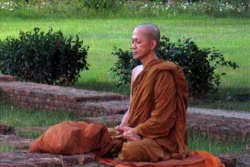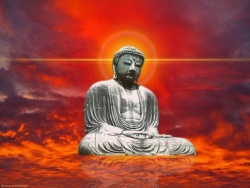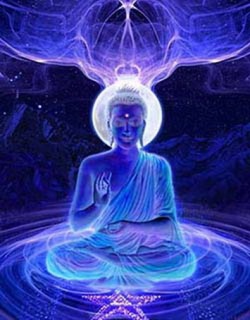Thai Buddhist Psychology and Character Analysis
Another aspect of the cultural complex of Thai religious belief is the existence of a belief in a kind of “soul stuff” in Thailand and other Southeast countries in the presence of Theravada Buddhism. If seen solely in terms of canonical Buddhism the belief in a “soul” appears contradictory. However, when viewed in the complex of Thai religiosity it becomes a part of a unique kind of sycretism that does not appear contradictory in the context of indigenous Buddhism.
Freudian notion of character — the id, ego, and superego — are not as universal as many Westerners may assume. While some Western Buddhists have tried to apply the term ego, and describe various practices in terms of Freudian psychology, we could argue that there is no ego at all, or that there is no getting rid of the ego; it is impermanent but here to stay. We do not want to get into these various arguments here, rather we would like to introduce you to some of the different parts of Thai character that have been influenced by Buddhist concepts.
There are a number of Thai character components. The two that have been referred to as the “soul” will be mentioned first and three other terms often used to describe a person’s character will follow. While these terms are listed in separate categories here — that is, divided into aspects of the person treated as a soul and the descriptions of character — there remains a great deal of overlap. And, naturally, in various regions of the country these notions are used differently and remain in flux:
There are two components often associated with a soul:
Khwan — This term has been defined variously as soul stuff (Phillips 1965: 34), the essence of life (Inge-Heinze 1982: 17), the soul element (Kirsch 1977: 255), and spirit essence or soul (Tambiah 1970: 57). This component is often associated with thirty-two different parts of the body and works as an aggregating force for them. This personal component can be lost in crucial situations-birth, life-threatening situations, or rites of passage. Khwan loss can be life threatening. In order to avert such a threat, the khwan can be ritualistically called back. Most often its most important role relates to maintaining the physical and psychological integrity of the person while he is alive. After death the fate of the khwan is of little importance; at that point the fate of the winyan is most significant.
Winyan (Pali, viññana; consciousness) — According to its Pali meaning this term refers to consciousness, the only aspect of the person that passes over to the next life, and then, according to Buddhism, this element of being has no personal attributes attached to it. Anuman (1968: 204) calls winyan the “modern Thai word for soul,” having obtained it after “adopt[ing] Buddhism of the Southern [[[Theravadan]]] School” (also see Inge-Heinze 1977: 337). Yet the belief in this element is different from khwan and does not have the elaborate ritual attached to it that khwan does. Primarily the focus of interest in winyan relates to contacting the spirits (that is, winyan) of the dead; it is the element of the human being that can "hang around" after one is deceased and either haunt people or, if contact is made, can be a source of valuable information. While khwan is of little concern after a person dies, contacting or righting the fate of a person’s winyan after death is of utmost concern. The powers attributed to some miracle-working monks (phra aphinihan) and lay mediums often include their ability to contact the spirits of the dead. That is, a holy man can increase his holiness by many times if he is able to get in touch with the winyan of great holy teachers (achan) before him. A leader of one religious movement with an ecumenical bent claimed to have been in touch with the spirits of Jesus, Mohammed, Napoleon, Nehru, and Gandhi, in addition to many Thai holy men.
Essentially, there are three aspects or descriptions of character:
Sandan (Pali, santana; continuity of subliminal consciousness) — This term is mentioned first because it can be related to both nature (genetics) and nurture (upbringing). According to its Pali roots, this concept tends to mean the ever-moving, ever-flowing panorama or continuity of successive mental states; in more common Thai usage it is held to be the intrinsic or inherent qualities of character, inborn traits, or innate character (even lineage, though rare). There is a Thai aphorism that says, sandon khut dai, tæ sandan khut mai dai (a sandbar can be dug away, but innate characteristics cannot be dug out).
The term sandan has a very strong pejorative meaning; not only does it refer to innate habits or characteristics, but these are held to be very bad characteristics. Also, sandan can be acquired through the milieu of a person’s upbringing. In other words — to use an example often mentioned when referring to sandan — a woman can have a tendency towards prostitution because her mother worked as a prostitute, or she could be forced to live in a situation exposing her to the “world’s oldest profession” and that this in turn could give her the sandan associated with this kind of lifestyle.
Once again, the folk beliefs relating to the “nature” aspects of sandan are not in line with normative Buddhist thinking on the matter of personality change and self-improvement; if people cannot “dig out” their sandan, they will find it difficult to make progress along the Buddhist path. If there is a Thai notion similar to the Greek “flawed character,” this is it. When certain people behave out of line (or even “out of character,” often meaning outside the bounds of the required action in a given context), their sandan will often be deemed the cause. The implied difficulty of changing sandan in this life (suggesting that further births are required to change these traits) can be seen as further evidence that the common Thai outlook regarding salvation is that it is a “long haul,” one that must be progressively carried out over the course of several lifetimes. Furthermore, this notion stands as a distinguishing characteristic of the common view of Theravada Buddhism that contrasts with certain aspects of Mahayana Buddhism, or the Northern School of Buddhism stressing “sudden enlightenment.”
Nisai (Pali, nissaya, that on which anything depends; often used in a material sense referring to the necessities of a monk, but nissayacariya can also be a teacher on whom one can depend) — this term has changed from the more specific Pali meaning to a broader definition meaning characteristics or habits. Nisai is used in a neutral way with the terms good (di) or bad (mai di) accompanying it for qualification. Nisai is used more often than the term bukkhalik or bukkhlikkaphap to refer to character or personality. When a person’s qualifications are stated, they are often put in terms of his or her nisai. For most Thai, the proper presentation of nisai is as important as other accomplishments; or to put this another way, one’s accomplishments may be overlooked or overshadowed by bad nisai. In this sense, a link can be made with the original sense of the Pali term: in Thai society, the success of a person’s movement and interaction very much depends on the quality of that person's nisai. This is in stark contrast to the leeway afforded (or perhaps even expectations held for) Western geniuses to be outrageous or eccentric and carouse outside of the normal realm of behavior, manners, or even sanity. A considerable portion of the biographies now included in Thai cremation volumes testify to the nisai of the deceased.
Chai or Chit-chai — This term refers to the heart or mind and is often used interchangeably. Most often a person’s nisai will be described in terms of the character of his chai, hence the large number of “chai” words used to describe people’s dispositions: good-natured (chai di), evil or literally ‘black-hearted’ (chai dam), generous (chai kwang), stingy (chai khæp), and so on. There is some belief that chai also refers to the essence of life, the breath (hai-chai). Anuman Rajadhon (1968: 212) has pointed out that being frightened is often referred to as chai hai-chai khwam (the heart is [temporarily] lost and has “flipped over”). (While the description of chai-hai above is similar to the description of khwan loss, chai-hai is far less serious than the loss of the khwan; it is a more common description of a feeling and is not grounds for a ritual to rectify that person's condition.)
The term “soul” is perhaps mainly a Western notion. In the case of the Thai people, the terms associated with soul deal with enduring notions of self but with some significant differences from Western concepts. The khwan, as stated above, relates primarily to this life and is much less personal than the Western notion of soul; paying attention to its loss can pose more immediate danger than the “loss of soul” often referred to in the West. If there is a notion of soul more akin to that of Western notions, it is winyan. For it is winyan that carries the karmic fruits of a person’s deeds; and so is winyan of more concern after a person has died and is awaiting rebirth. Therefore, while we may generally refer to these concepts as “soul,” neither matches nor encompasses the typical Western perceptions.
Furthermore, while a person’s character or “face” is usually stated in terms of nisai first and then the other aspects of personality, it will become clear that when considering the elements of Thai personality listed above, khwan serves as the aggregating force. In other words, no matter how good (nisai di or chai di) a person may be, if his khwan is lost or unsettled, the person is not balanced and is in a precarious state (whether it is immediately apparent or not).
Sandan, nisai, and chit-chai are usually used to describe or judge the quality of the character of a person. Whereas, while one is alive, khwan stands as the integrating element of Thai personhood. While translated in various ways, the khwan is usually defined as a kind of soul or guardian spirit that is part of an extremely ephemeral essence (Tambiah 1970: 58). The khwan can become unsettled, leave the body, and require “calling back” (riak khwan).
There are a number of other situations in which a person can lose track of his khwan as well. If a person falls suddenly or is in an accident and experiences shock, this may be sufficient grounds for khwan loss. If a person is frightened by someone, his khwan might be lost (hai) or escape (ni), presumably because he did not have his wits about him at the time or subsequently “lost his wits.” The same thing may happen to a woman who is touched by a man before she is willing. The shock of her sensation and the sudden arising of other feelings can be so overwhelming that her khwan may seek flight. In these latter examples, shock or confusion results in diffusion; and diffusion must be repaired.
The notion of the khwan, therefore, is a way of objectifying a feeling or sensation — usually of uneasiness — and caring for it or repairing it. Viewed this way, the notion of khwan is not so much an objectification of a metaphysical notion, as Tambiah (1970: 243) has put it, but rather the objectification of the subjective.
Furthermore, other aspects of Thai psychology can even be traced to Buddhist roots; for example, arom or mood (Pali, arammana). The Thai word for mood can be traced to the Buddhist notion of mind-object. A person’s mood is determined by clinging to a mind-object, or a mood is sustained by the nature of the tinder (chua) of the fire of the mind. Redirecting the object of one’s attention, refocusing one’s mind, is a means to a better state of mental health. When someone is depressed (or even contemplating suicide) the Thai people often say, “khit san,” think of the short-term, do not go too far out.


